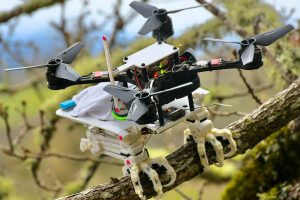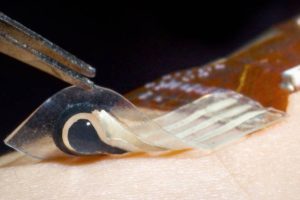
“It’s not easy to mimic how birds fly and perch,” said Stanford engineer William Roderick. “After millions of years of evolution, they make take-off and landing look so easy, even among all of the complexity and variability of the tree branches you would find in a forest.”
The researchers studied small birds called parrotlets, videoing them flying to and from special perches which included force sensors, and were surfaced with materials included wood, foam, sandpaper and PTFE.
“What surprised us was that they did the same aerial maneuvers, no matter what surfaces they were landing on,” said Roderick. “They let the feet handle the variability and complexity of the surface texture itself.”
To work out how the feet responed to this complexity, they studied the bones, muscles and tendons in the legs and feet of the perigrine falcon, then mimicked them with 3D printed plastic, motors and fishing line. The falcon was chosen as its weight is similar to the quadcopter that was to provide the bird-bot’s ‘wings’.
After 20 itterations, they had created the SNAG – ‘stereotyped nature-inspired aerial grasper’, where stereotyped represents the formulaic landing technique of all birds studied.
Each leg has its own motor for moving back and forth, and another to handle grasping. Nylon tendons run around the ankle to mimic the way bird legs absorb landing impact energy, passively converting it to grasping force.
“The result is that the robot has an especially strong and high-speed clutch that can be triggered to close in 20ms,” according to the university. “Once wrapped around a branch, SNAG’s ankles lock, and an accelerometer on the right foot reports that the robot has landed and triggers a balancing algorithm to stabilise it.”
Peregrines are anisodactyl, with three toes at the front and one at the back back, so the team also mimicked zygodactyl feet with two toes at the front and two at the back like a parrotlet. They found, to their surprise, said the university, that there was very little performance difference.
As well as perching, the SNAGs also caught objects in flight and carried them with no modification.
Already the bird-bot had been equipped with temperature and humidity sensors and used to study micro-climates in the forests of Oregon.
“Part of the underlying motivation of this work was to create tools that we can use to study the natural world,” said Roderick. “If we could have a robot that could act like a bird, that could unlock completely new ways of studying the environment.”
The work is decribed in Science Robotics the clearly-written and easily accessible paper ‘Bird-inspired dynamic grasping and perching in arboreal environments’ – the whole paper can be read without paymment. There is an excellent Stanford bird robot video.
(The paper is worth at least a browse, and the video is thankfully free from the marketing drivel that has become common from other universities, Ed)
 Electronics Weekly Electronics Design & Components Tech News
Electronics Weekly Electronics Design & Components Tech News

